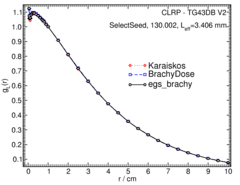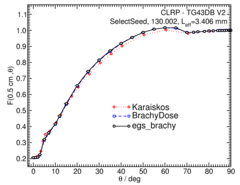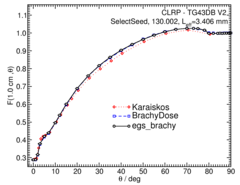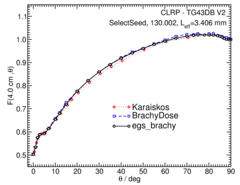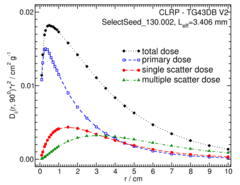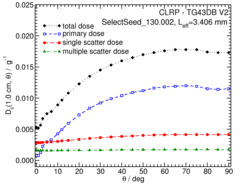
Source Description:
The SelectSeed source 1 dimensions are taken from the study by Karaiskos et al 1 . The source element for the SelectSeed is a cylindrical silver rod with an outer diameter of 0.510 mm and a length of 3.40 mm. The rod is coated with a silver halide layer (AgCl/AgI) that is 3.0 μm thick. The titanium encapsulation has a 0.80 mm outer diameter and is 0.050 mm thick. End welds are 0.40 mm thick and hemispherical in shape. The overall length is 4.50 mm and the active length of the source is 3.406 mm. The cylindrical source element is free to move approximately 0.29 mm along the seed axis and 0.092 mm radially from the center of the seed, however, we assume the silver rod is always centred. The mean photon energy calculated on the surface of the source is 27.23 keV with statistical uncertainties < 0.010%.Dose-Rate Constant - Λ :
Dose-rate constants, Λ , are calculated by dividing the dose to water per history in a (0.1 mm)3 voxel centered on the reference position, (1 cm,Π/2), in the 30x30x30 cm3 water phantom, by the air-kerma strength per history (scored in vacuo). As described in ref. 2 , dose-rate constants are provided for air-kerma strength calculated using voxels of 2.66x2.66x0.05 cm3 (WAFAC) and 0.1x0.1x0.05 cm3 (point) located 10 cm from the source. The larger voxel size averages the air-kerma per history over a region covering roughly the same solid angle subtended by the primary collimator of the WAFAC 3, 4 at NIST used for calibrating low-energy brachytherapy sources and is likely the most clinically relevant value. The small voxel serves to estimate the air kerma per history at a point on the transverse axis and includes a small 1/r2 correction (0.5%) 2. MC uncertainties are statistical uncertainties only (k=1).
| Author | Method | Λ (cGy h-1 U-1) | Abs. Uncertainty |
| Safigholi et al 5 | WAFAC | 0.921 | 0.0003 |
| Safigholi et al 5 | point | 0.948 | 0.0022 |
| Taylor, Rogers 6 | WAFAC | 0.917 | 0.002 |
| Taylor, Rogers 6 | point | 0.944 | 0.003 |
| Karaiskos et al 1 | MC | 0.954 | 0.005 |
| Anagnostopoulos et al 7 | TLD | 0.938 | 0.065 |
| Papagiannis et al 8 | TLD | 0.987 | 0.077 |
| Rodriguez, Rogers 9 | TLD Revised (Anagnostopoulos) | 0.885 | 0.056 |
| Rodriguez, Rogers 9 | WAFAC (BrachyDose) | 0.917 | 0.015 |
| Rivard et al 10 | TG43U1S2 consensus value | 0.954 | 0.043 |
Radial dose function - g(r):
The radial dose function, g(r), is calculated using both line and point source geometry functions and tabulated at 36 different radial distances ranging from 0.05 cm to 10 cm. Fit parameters for a modified polynomial expression are also provided 11 . The mean residual deviations from the actual data for the best fit were < 0.16%. Also, extrapolation of g(r) vlaues from 10 cm to 15 cm with current fitting coefficients values showed a mean differences of 0.8% compared to g(r) values which are extracted from an egs_brachy simulation in a 40 cm (height) by 40 cm (diameter) water phantom, i.e. the fit extrapolates well to larger distances.
| Fitting coefficients for g L (r) = (a0 r-2 + a1 r-1 + a2 + a3r + a4r2 + a5 r3) e-a6r | |||
| Fit range | Coefficients | ||
| r min (cm) | r max (cm) | ||
| 0.05 | 10.0 | a0 / cm2 | (8.18+/-0.17)E-04 |
| a1 / cm | (-1.97+/-0.04)E-02 | ||
| a2 | (1.1853+/-0.0022)E+00 | ||
| a3 / cm-1 | (3.50+/-0.14)E-01 | ||
| a4 / cm-2 | (-1.16+/-0.23)E-02 | ||
| a5 / cm-3 | (1.21+/-0.10)E-03 | ||
| a6 / cm-1 | (4.11+/-0.10)E-01 | ||
Anisotropy function - F(r,θ):
Anisotropy functions are calculated using the line source approximation and tabulated at radii of 0.1, 0.15, 0.25, 0.5, 0.75, 1, 2, 3, 4, 5, 7.5 and 10 cm and 32 unique polar angles with a minimum resolution of 5 o . The anisotropy factor, φ an (r), was calculated by integrating the solid angle weighted dose rate over 0 o ≤ ϑ ≤ 90 o .
Primary and Scatter Separated (PSS) Dose Data: D ii (r,θ):
Primary and Scatter Separated (PSS) dose data are tabulated at 24 radii from 0.1 cm to 10 cm and 24 unique polar angles with a minimum resolution of 5 o . High resolution (Δr = 1 mm, ΔΘ = 1 o ) primary scatter dose data are also available in .csv files. For the purposes of these calculations, scatter within the source is not considered as scatter and any photon escaping the source encapsulation is considered a primary. Only photons which scatter within the phantom are counted in the scatter tallies. Doses are normalized to the total photon energy escaping the encapsulation.
Photon Energy Spectra
Photon energy spectra generated by the source model is calculated using egs_brachy surface count scoring option to get the spectrum on the surface of the source. The relative counts here is the counts per 0.1 keV bin per MeV normalized to 1 count total in the spectrum.The MC calculations have a statistical uncertainty less than 0.0.01% on the mean energy. The spectrum data are available in xmgrace format below.
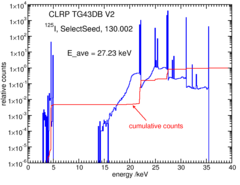
Energy weighted photon spectrum data: xmgrace
Tabulated data:
Tabulated data is available in .xlsx format: Excel
References:
1. Karaiskos et al , Monte Carlo dosimetry of the selectSeed 125 I interstitial brachytherapy seed, Med. Phys., 28 , 1753-1760, 2001
2. R. E. P. Taylor et al , Benchmarking BrachyDose: voxel-based EGSnrc Monte Carlo calculations of TG-43 dosimetry parameters, Med. Phys., 34 , 445 - 457, 2007
3. R. Loevinger, Wide-angle free-air chamber for calibration of low--energy brachytherapy sources, Med. Phys., 20 , 907, 1993
4. S. M Seltzer et al , New National Air-Kerma-Strength Standards for 125 I and 103 Pd Brachytherapy Seeds, J. Res. Natl. Inst. Stand. Technol., 108 , 337 - 358, 2003
5. H. Safigholi, M. J. P. Chamberland, R. E. P. Taylor, C. H. Allen, M. P. Martinov, D. W. O. Rogers, and R. M. Thomson, Update of the CLRP TG-43 parameter database for low-energy brachytherapy sources, to be published (Current calculation).
6. R. E. P. Taylor, D. W. O. Rogers, An EGSnrc Monte Carlo-calculated database of TG-43 parameters, Med. Phys.,35 , 4228-4241, 2008
7. G. Anagnostopoulos et al , Thermoluminescent dosimetry of the selectSeed 125 I interstitial brachytherapy seed, Med. Phys., 29 , 709-716, 2002
8. P. Papagiannis et al , On the dose rate constant of the selectSeed 125 I interstitial brachytherapy seed, Med. Phys., 33 , 1522-1523, 2006
9. M. Rodriguez , D. W. O. Rogers, Effect of improved TLD dosimetry on the determination of dose rate constants for 125I and 103Pd brachytherapyseeds, Med.Phys. 41, 114301-15,2014. 10. M. J. Rivard et al , Supplement 2 for the 2004 update of the AAPM Task Group No. 43 Report: Joint recommendations by the AAPM and GEC-ESTRO, Med. Phys., 44 , e297-e338, 2017
11. R. E. P. Taylor, D. W. O. Rogers, More accurate fitting of 125I and 103Pd radial dose functions, Med. Phys., 35 , 4242-4250, 2008
